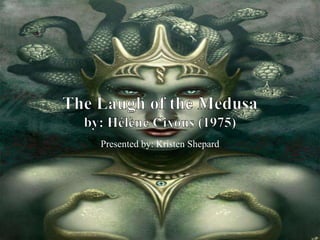
The laugh of the medusa
- 1. The Laugh of the Medusaby: Hélène Cixous (1975) Presented by: Kristen Shepard
- 2. Introduction Written in 70’s at height of Women’s Liberation Movement. Why is it titled “The Laugh of the Medusa?” Medusa is a mythical female figure known for her stare which turned “victims” (especially men) into stone. So is Medusa laughing because she overcomes male dominance?
- 3. Main Idea Women can either read the essay and “choose to stay trapped in their own bodies by a language that does not allow them to express themselves, or they can use their bodies as a way to communicate.” The language regularly expected is male centered which hinders the women’s ability to “truly” express herself as a woman.
- 4. I. The Future vs. the Past The hope for change in the future by women writing as women for women Belief that “the future must no longer be determined by the past” (1643) Effects of the past are still with us, but refusal to repeat them will strengthen the future Need to escape repressive past Men who typically repress women Women who go against other women because of male influence
- 5. I. The Future vs. the Past (cont.) Says talks about the “mark of our time” and goes on to say it is a “time during which the new breaks away from the old, and, more precisely, the (feminine) new from the old (la nouvelle de l’ancien). Thus, as there are no grounds for establishing a discourse, but rather an arid millennial ground to break, what I say has at least two sides and two aims: to break up, to destroy; and to foresee the unforeseeable, to project.” (1643) Negative references about women – “dark, bad, witches, abyss, below, and beyond”
- 6. II. Women’s Repression Women led to hate women by men’s influence (self-hate/antinarcissism) Women’s repression leads to the need to speak (break from silence) Few “real” feminine writings; many women writings follow male conventions Poetry only exception, but the form is more emotion based (thus okay for women - fairies)
- 7. III. Women’s Liberation Women’s need to be heard (Connection between body and speech) Women must “write themselves” (1643) Idea of mother in every woman “white ink” – all women has ability to nurture with milk (Again connecting women’s body with writing) Comparison between women writing and female masturbation ― Both give women pleasure ― Women made to feel guilt afterward ― Both must be done in private and not public sphere
- 8. IV. Concept of Bisexuality Women who “cut themselves out a paper penis” (1649) Writing is neuter, thus bisexual In essence in between typical binary “Each one’s location in self . . . variously manifest and insistent according to each person, male or female . . .” (1649) Men’s fear of being a woman by castration (wish not to be “bisexual”) Fantasy of “total” being (though composed of two halves)
- 9. V. The Dark Continent Connection between female and dark “Neither dark nor unexplorable” (1650) Men made women believe in “white continent” (connects to men/dominant) with monuments to Lack Put women “between two horrifying myths: between the Medusa and the abyss” (1650) Medusa usually depicted as ugly woman with head full of phallic snakes The abyss is frightening because it is unknown and mysterious and could be harboring monsters in the dark
- 10. VI. The Flying Mother When the repressed collective "woman" returns it will be an explosive return Woman has always functioned within the discourse of man, she must invent her own language Flying is woman's language. Woman can fly because she can both give her body unselfishly (she does this in flight, when she does not cling to her body), and she can claim the joyous benefits of her body for herself. “Voler” also means to steal Fly is metaphor for obtaining own voice
- 11. *Something to Think About Cixous uses the word “flying” to describe a sense of escape for women. If we consider mythology for a second, Pegasus, a white, winged horse sprang from Medusa’s head after she was killed by Perseus. The head is typically associated with the male (head=reason/logic) and white horses usually symbolize freedom and power. The question then may arise (considering Cixous references) does it mean that the male was at the core of this “evil” female all along or does it mean that male power and logic has roots in the female? (This would connect considering Cixous references women as nurturers and the bearing of children).
- 12. VII. Some Notable Influences Sigmund Freud Gender roles Sexual identity Oedipal complex – “the only good father is a dead one” (1654) Mention of penis envy Jacques Derrida Signified and signifier Link between speech and writing Logocentrism Binary opposition Jacques Lacan Symbol for desire Development of gender roles in childhood Combined Derrida and Lacan’s theories to create term phallogocentrism
- 13. Discussion Questions 1. What justification is there for Hélène Cixous to compare female writing to the female body and how does that differ from their male counterparts? Cixous also makes a connection between writing and speaking. What does this say about her beliefs in women’s voices and the restraint thereof? 2. What does Cixous mean by the “universal woman” (1644) and how does that compare to Butler’s reference to a “natural woman” in Aretha Franklin’s song? 3. In what ways does Cixous use the idea of “lack” or other “Other” classifications?